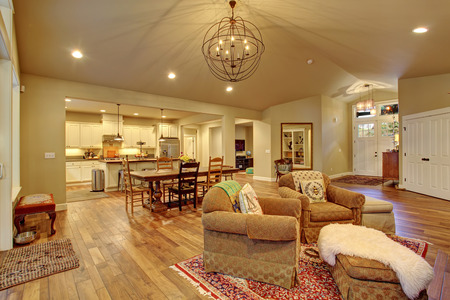Introduction to Basement Flooring
When it comes to remodeling or finishing a basement in an American home, choosing the right flooring is one of the most important decisions youll make. Basements are unique compared to other rooms in your house because they have specific challenges and needs. Understanding these challenges can help you pick the best flooring option for your space, lifestyle, and budget.
Unique Challenges of Basement Flooring
Basements are often below ground level, which means they deal with issues that upstairs rooms usually don’t face. Here’s a quick look at what makes basement flooring different:
| Challenge | Description | Why It Matters |
|---|---|---|
| Moisture | Basements can be damp or even get flooded due to leaks or high humidity. | Certain floor types can warp, mold, or get damaged easily if they aren’t moisture-resistant. |
| Insulation | Basements tend to be cooler than above-ground spaces. | Proper insulation in flooring keeps the area warm and comfortable. |
| Usage Needs | Basements are used for many purposes: playrooms, gyms, bedrooms, laundry rooms, and more. | The right flooring depends on how you plan to use your basement space. |
Considerations Before Choosing Your Basement Floor
- Budget: Some options are very affordable, while others can be more expensive due to materials and installation costs.
- Comfort: If you’ll spend a lot of time downstairs, comfort underfoot is key.
- Aesthetics: The look and feel you want—modern, cozy, durable—should guide your choice.
- Maintenance: Some floors require more upkeep than others. Think about what fits your lifestyle.
- Potential for Water Issues: Even with a dry basement now, consider possible future water problems when making your selection.
Main Types of Basement Flooring Problems in American Homes
The most common issues homeowners face with basement flooring are related to water damage and cold temperatures. By understanding these factors from the start, you can choose a floor that stands up to whatever life (and the weather) throws at it. In the next sections, we’ll explore top basement flooring options—along with their pros, cons, and the best situations for each type—so you can make an informed decision for your own home.
Luxury Vinyl Plank (LVP) and Tile (LVT)
Why LVP and LVT Are Top Choices for Basements
Luxury Vinyl Plank (LVP) and Luxury Vinyl Tile (LVT) are two of the most popular flooring options for basements in the U.S. today. Their rise in popularity comes down to three big advantages: water resistance, durability, and design versatility. Basements can be prone to moisture issues, making traditional hardwood or carpet a risky pick. LVP and LVT offer a practical solution that stands up well to these challenges.
Key Features of LVP and LVT
| Feature | LVP / LVT |
|---|---|
| Water Resistance | Excellent – Great for damp or flood-prone areas |
| Durability | Scratch, dent, and stain resistant; holds up to heavy use |
| Design Options | Wide variety of colors, patterns, and textures—mimics wood, stone, tile |
| Comfort & Warmth | Softer and warmer underfoot compared to tile or concrete |
| Ease of Installation | DIY-friendly; click-lock or glue-down systems available |
| Maintenance | Low maintenance—easy to clean with basic household cleaners |
Pros and Cons at a Glance
| Pros | Cons |
|---|---|
| – Highly water-resistant – Durable against wear and tear – Affordable compared to hardwood – Variety of style choices – Easy installation and repair – Comfortable underfoot |
– Can feel less authentic than real wood or stone – May fade over time with prolonged sunlight exposure – Not as eco-friendly as natural materials |
Best Use Cases for Basement Spaces
LVP and LVT shine in spaces where comfort, resilience, and style matter. Here are some common basement uses where these floors excel:
- Family Rooms: The soft feel and warmth make them ideal for playrooms, media rooms, or hangout spots.
- Home Gyms: They absorb impact well and resist sweat or spills better than carpet.
- Laundry Rooms: Water resistance is perfect for accidental leaks.
- Basement Bedrooms: Warmer than tile but easier to keep clean than carpet.
- Offices or Studios: Stylish looks combined with easy upkeep create a professional yet inviting space.
![]()
3. Carpeting for Comfort
Why Choose Carpet for Your Basement?
Carpeting is a popular choice for basements, especially if you want to create a cozy, inviting space. Carpet adds warmth and softness underfoot, making it ideal for areas where people gather or spend a lot of time on the floor.
Pros and Cons of Basement Carpeting
| Pros | Cons |
|---|---|
| Provides warmth and insulation against cold basement floors | Susceptible to mold and mildew if exposed to moisture |
| Excellent sound dampening, reducing echo and noise | Can retain odors over time, especially in humid environments |
| Soft and comfortable for playrooms or bedrooms | Difficult to clean after spills or flooding |
| Wide range of colors and styles available | Not suitable for areas with frequent water leaks or high humidity |
Best Use Cases for Basement Carpeting
- Playrooms: Soft surface makes it safe and comfortable for kids to play.
- Bedrooms: Adds a cozy touch and helps keep feet warm in the morning.
- Home Theaters: Excellent sound absorption enhances movie watching experience.
- Lounges: Perfect for creating a relaxing area for family gatherings or reading nooks.
Tips for Successful Carpet Installation in Basements
- Select carpet tiles or low-pile options, as they are easier to replace if damaged by moisture.
- Always use a moisture barrier pad underneath the carpet to reduce the risk of water damage.
- If your basement is prone to occasional dampness, consider professional waterproofing before installation.
- Regularly check and maintain your basement’s humidity levels to prevent mold growth.
4. Engineered Wood and Laminate
What Are Engineered Wood and Laminate Floors?
Engineered wood flooring is made from a real wood veneer attached to layers of plywood or high-density fiberboard, giving it the look and feel of solid hardwood but with added stability. Laminate flooring, on the other hand, consists of a photographic layer that mimics wood (or other materials) over a composite base. Both options offer attractive alternatives for basements where traditional hardwood isn’t practical due to moisture concerns.
Why Consider These Options for Basements?
Basements often have concrete subfloors and can be prone to moisture. Engineered wood and laminate floors are designed to handle these challenges better than solid hardwood. Their layered construction helps reduce warping or shifting, making them more stable choices for below-grade spaces.
Main Features at a Glance
| Feature | Engineered Wood | Laminate |
|---|---|---|
| Appearance | Real wood look and feel | High-quality printed image of wood or stone |
| Moisture Resistance | Better than solid hardwood | Good (but avoid standing water) |
| Installation | Floating or glue-down | Click-lock floating installation |
| Comfort Underfoot | Warm, natural feel | Slightly firmer, but comfortable with underlayment |
Pros and Cons
| Pros | Cons | |
|---|---|---|
| Engineered Wood | – Looks like real hardwood – More stable over concrete – Can be refinished (depending on thickness) |
– More expensive than laminate – Still not waterproof – Sensitive to extreme humidity changes |
| Laminate | – Budget-friendly – Wide variety of styles – Easy DIY installation – Good scratch resistance |
– Not real wood – Can swell if exposed to water – Cannot be refinished if damaged |
Best Use Cases in the Basement
- Finished basements used as family rooms or playrooms: Both engineered wood and laminate create a cozy, inviting atmosphere.
- Home offices: Their professional appearance makes them ideal for workspace conversions in the basement.
- Low-moisture areas: If your basement is dry and well-sealed, either option works well.
Where to Avoid Installation
- Avoid using engineered wood or laminate in laundry areas or any spot with a high risk of water leaks, as neither is truly waterproof.
5. Concrete, Tile, and Alternative Solutions
Polished or Stained Concrete
Concrete is a classic basement flooring option, especially for those looking for something durable and low-maintenance. Polished or stained concrete can be surprisingly stylish, with modern finishes that suit both industrial and contemporary homes. Its easy to clean and resistant to water damage—making it perfect for basements prone to moisture.
Best Use Cases:
- Laundry rooms
- Workshops
- Home gyms
Pros and Cons of Concrete Flooring
| Pros | Cons |
|---|---|
| Extremely durable and long-lasting | Can feel cold and hard underfoot |
| Resistant to water and stains when sealed properly | May require area rugs for comfort |
| Low maintenance | Cracks may develop over time |
| Customizable with stains or polishing for unique looks | Professional installation recommended for best results |
Ceramic Tile Flooring
Ceramic tile is another solid choice for basement floors. It’s available in countless styles, colors, and patterns, allowing homeowners to create the look they want. Tiles are water-resistant and easy to wipe clean, making them ideal for spaces where spills or dampness are common.
Best Use Cases:
- Laundry rooms or bathrooms in the basement
- Basement kitchens or wet bars
- Entryways from outside or garage access points
Pros and Cons of Ceramic Tile Flooring
| Pros | Cons |
|---|---|
| Highly water-resistant and easy to clean | Cold to the touch without radiant heating systems |
| Wide variety of designs and colors available | Tiles can crack if subfloor shifts or is uneven |
| Great for allergy sufferers (non-porous surface) | Grout may need periodic sealing or cleaning |
| Suits high-traffic areas well | Difficult DIY installation unless you have experience |
Alternative Flooring: Rubber & Cork Options
If youre looking for something softer underfoot, rubber and cork floors are excellent alternatives. These materials add comfort, provide some insulation, and absorb sound—making them favorites for family-friendly basements or entertainment spaces.
Best Use Cases:
- Home theaters (sound absorption)
- Kid playrooms (soft, cushioned surface)
- Exercise spaces (shock absorption)
Pros and Cons of Rubber & Cork Flooring
| Rubber Flooring | Cork Flooring | |
|---|---|---|
| Durability | Very durable, resists dents and scratches | Softer but can dent under heavy furniture |
| Water Resistance | Mold/mildew resistant; great in damp areas | Naturally moisture resistant but not waterproof |
| Maintenance | Mop clean with mild soap; minimal upkeep | Sweep/vacuum regularly; occasional sealing needed |
| Main Uses | Kid’s rooms, gyms, workshops | Theaters, bedrooms, yoga studios |
No matter which you choose—polished concrete for durability, ceramic tile for style, or alternative options like rubber or cork for comfort—you’ll find a solution that fits your basement’s purpose while standing up to the unique challenges of below-grade living spaces.


